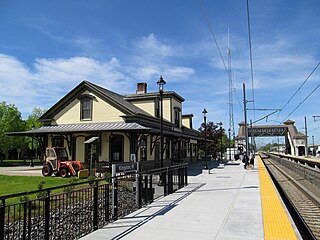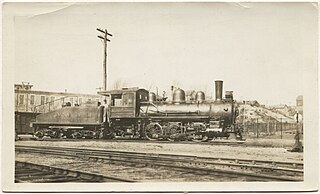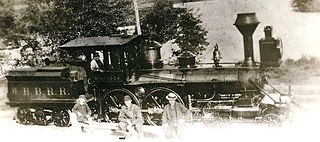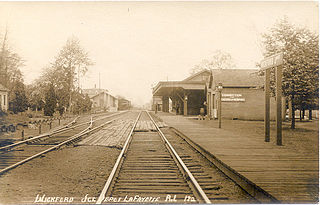
South Kingstown is a town in, and the county seat of, Washington County, Rhode Island, United States. The population was 31,931 at the 2020 census. South Kingstown is the second largest town in Rhode Island by total geographic area, behind New Shoreham, and the third largest town in Rhode Island by geographic land area, behind Exeter and Coventry.
Potowomut is an isolated neighborhood and a peninsula in Warwick, Rhode Island. It is bordered by the Town of East Greenwich to the northwest, and by North Kingstown to the southeast. Greenwich Bay surrounds all other sides.
The Narragansett Council of Scouting America serves all of the state of Rhode Island and some of Massachusetts and Connecticut. Its several camps include Camp Yawgoog, Champlin Scout Reservation, and Camp Norse.

Scouting in Rhode Island has a long history, from the 1910s to the present day, serving thousands of youth in programs that suit the environment in which they live.

The Providence and Worcester Railroad is a Class II railroad operating 612 miles (985 km) of tracks in Rhode Island, Massachusetts, and Connecticut, as well as New York via trackage rights. The company was founded in 1844 to build a railroad between Providence, Rhode Island, and Worcester, Massachusetts, and ran its first trains in 1847. A successful railroad, the P&W subsequently expanded with a branch to East Providence, Rhode Island, and for a time leased two small Massachusetts railroads. Originally a single track, its busy mainline was double-tracked after a fatal 1853 collision in Valley Falls, Rhode Island.

The New York, Providence and Boston Railroad, normally called the Stonington Line, was a major part of the New York, New Haven and Hartford Railroad between New London, Connecticut and Providence, Rhode Island. It is now part of Amtrak's high-speed Northeast Corridor.

Wickford is a small village in the town of North Kingstown, Rhode Island, United States, which is named after Wickford in Essex, England. Wickford is located on the west side of Narragansett Bay, just about a 20-minute drive across two bridges from Newport, Rhode Island. The village is built around one of the most well-protected natural harbors on the eastern seaboard, and features one of the largest collections of 18th century dwellings to be found anywhere in the Northeast. Today the majority of the village's historic homes and buildings remain largely intact upon their original foundations.

Kingston is a historic railroad station located on the Northeast Corridor in the village of West Kingston, in the town of South Kingstown, Rhode Island. It was built at this location in 1875 by the New York, Providence and Boston Railroad, replacing earlier stations dating back to the opening of the line in 1837. Current rail services consist of Northeast Regional trains in each direction, most of which stop at the station. Historically Kingston provided commuter rail service to Providence and Boston via Amtrak's commuter rail services. The MBTA is looking at extending their commuter service on the Providence/Stoughton Line.

The Fall River Line was a combination steamboat and railroad connection between New York City and Boston that operated between 1847 and 1937. It consisted of a railroad journey between Boston and Fall River, Massachusetts, where passengers would then board steamboats for the journey through Narragansett Bay and Long Island Sound to the line's own Hudson River dock in Manhattan. For many years, it was the preferred route to take for travel between the two major cities. The line was extremely popular, and its steamboats were some of the most advanced and luxurious of their day.
RISN Operations Inc., also called Rhode Island Suburban Newspapers, is a privately owned publisher of three daily newspapers and several weekly newspapers in the U.S. state of Rhode Island. The company was founded by Illinois-based newspaper executives in early 2007 to purchase the Rhode Island holdings of Journal Register Company, which it did for $8.3 million.

Chepiwanoxet is a neighborhood in Warwick, Rhode Island, with an island peninsula in Greenwich Bay, an arm of Narragansett Bay. The neighborhood straddles the Amtrak railroad lines, which lies just east of and parallel to the Post Road. Its boundaries are Neptune Street to the North, Alger Avenue to the South, Post Road to the West, and Greenwich Bay to the East. Chepiwanoxet Way, an underpass beneath the Amtrak lines, now serves as the only street access in and out of the neighborhood.

The Narragansett Pier Railroad was a railroad in southern Rhode Island, running 8.5 miles (13.7 km) from West Kingston to Narragansett Pier. It was built by the Hazard family of Rhode Island to connect their textile mills in Peace Dale to the New York, Providence and Boston Railroad at Kingston Station, as well as to ocean-going steamboats at Narragansett Pier. Upon opening in 1876, the railroad also proved crucial in the growth of Narragansett Pier into a major resort. Initially operated at a loss absorbed by the Hazards, by the 1890s the railroad became consistently profitable and handled a brisk passenger business along with freight and mail shipments. The Hazards also operated a connecting steamboat service to Newport.

Washington County, known locally as South County, is a county located in the U.S. state of Rhode Island. As of the 2020 census, the population was 129,839. Rhode Island counties have no governmental functions other than as court administrative boundaries, which are part of the state government.
Crescent Park was an amusement park in Riverside, East Providence, Rhode Island which ran from 1886 to 1979. The park was known for its Rhode Island Shore Dinners, the Alhambra Ballroom, and its midway.

The William C. O'Neill Bike Path is a paved rail trail extending from Kingston station parking lot in West Kingston, Rhode Island, to Mumford Road in Narragansett, Rhode Island. The whole path is in Washington County, Rhode Island. The trail is 6.8 miles (11 km) long, largely on the former right of way of the Narragansett Pier Railroad. An extension opened up to the University of Rhode Island in 2019. A future extension will bring it to Boston Neck Road.
The 243rd Coast Artillery Regiment was a Coast Artillery Corps regiment in the Rhode Island National Guard. It garrisoned the Harbor Defenses of Narragansett Bay, Rhode Island 1924–1944.

The Warwick Railway was a railroad in Rhode Island, United States. It was originally chartered in 1873 under the name Warwick Railroad, with a route connecting Cranston to Oakland Beach, eight miles (13 km) away. Opened in 1875, the company survived until 1879 when it declared bankruptcy and shut down; it was resurrected in 1880 as the Rhode Island Central Railroad under New York, Providence and Boston Railroad (NYP&B) ownership and extended by two miles (3.2 km) in length. Following the New York, New Haven and Hartford Railroad's purchase of the NYP&B in 1892, operations continued with steam power until the Rhode Island Central Railroad's 1899 consolidation with the Rhode Island Suburban Railway, at which point the line was electrified and trolleys replaced steam locomotives. Control subsequently passed to the United Electric Railways in 1921. Passenger trolley service was discontinued in 1935, but freight service continued; the following year, the line was cut back from its 10 mile maximum length to just two miles (3.2 km).

The Moshassuck Valley Railroad, founded in 1874, was a shortline railroad in Rhode Island, United States. Built from 1876 to 1877, it operated on a 2-mile (3.2 km) long line between Lincoln and a connection to the Providence and Worcester and Boston and Providence railroads, both of which were subsequently purchased by the New York, New Haven and Hartford Railroad, in the Woodlawn neighborhood of Pawtucket. The company was formed by the Sayles brothers, owners of a significant mill in Saylesville near the line's terminus. Freight was the primary traffic of the railroad, but frequent passenger service was also provided by a self-propelled steam passenger car until 1921.

The Wood River Branch Railroad was a shortline railroad in Rhode Island, United States. Chartered in 1872 and opened on July 1, 1874, the 5.6-mile (9.0 km) line operated until 1947. It connected Hope Valley, Rhode Island, to the New York, Providence and Boston Railroad mainline at Wood River Junction. Though always nominally independent, the company was closely affiliated with the Stonington Line and its successor, the New York, New Haven and Hartford Railroad, which held significant portions of its stock.

The Newport and Wickford Railroad and Steamboat Company was a railroad and steamboat operator in Rhode Island. It was first chartered in 1862 as the Wickford Branch Railroad, and intended to connect Wickford Junction station to downtown Wickford, Rhode Island, by rail, and Wickford to Newport, Rhode Island, by steamboat. The company changed its name to the Wickford Railroad in 1864, before adopting its final name in 1870. Construction was completed in 1871, when the railroad began hauling both passengers and freight with a single locomotive and two railroad cars. Steamboats were purchased to connect to Newport. The railroad operated under the control of the New York, Providence and Boston Railroad, but maintained its own corporate identity until a 1909 takeover by the New York, New Haven and Hartford Railroad. Passenger trains and the steamboat service were both ended in October 1925, and the final half a mile to Wickford Landing was abandoned in 1938. The rest of the line was abandoned by the New Haven in 1962.
















